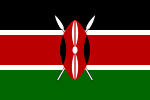Biikap Kuutiit ('Speech community'), Miot | |
|---|---|
| Total population | |
| 6,641,952 | |
| Regions with significant populations | |
| 6,358,113[1] | |
| 273,839[2] | |
| 10,000 | |
| Languages | |
| Religion | |
| Christianity, Kalenjin Mythology | |
| Related ethnic groups | |
| Daasanach people, Datooga people and Omotik people | |
| Part of a series on the |
| Culture of Kenya |
|---|
 |
| Cuisine |
The Kalenjin is a group of tribes indigenous to East Africa, residing mainly in what was formerly the Rift Valley Province in Kenya and the eastern slopes of Mount Elgon in Uganda. They number 6,358,113 individuals per the Kenyan 2019 census and an estimated 273,839 in Uganda according to the 2014 census mainly in Kapchorwa, Kween and Bukwo districts.[3]
The Kalenjin have been divided into 11 culturally and linguistically related tribes: Kipsigis (1.9 million), Nandi (937,000), Pokots (778,000), Sebei (350,000), Sabaot (296,000), Keiyo (451,000), Tugen (197,556), Cherengany 8,323, Marakwet (119,000), Ogiek (52,000), Terik (323,230), Lembus (71,600) and Sengwer (10,800).[4] The Kalenjin speak the Kipsigis languages but can also be inclusive of Akie language in Tanzania and Pokot language spoken in Kenya; all being classified collectively as Kalenjin Language; while in combination with Datooga languages of Tanzania, this cluster is called Southern Nilotic languages.[5] The Kalenjin language, along with the languages of the Datooga people of Tanzania, the Maasai, Luo, Turkana, Nuer, Dinka among others are classified as Nilotic languages.
- ^ Cite error: The named reference
Census2019was invoked but never defined (see the help page). - ^ Uganda Bureau of Statistics. "National Population and Housing Census 2014 - Main Report" (PDF).
- ^ Uganda Bureau of Statistics. "National Population and Housing Census 2014 - Main Report" (PDF).
- ^ "Kalenjin – Introduction, Location, Language, Folklore, Religion, Major holidays, Rites of passage". everyculture.com. Retrieved 7 April 2022.
- ^ Cite error: The named reference
:1was invoked but never defined (see the help page).